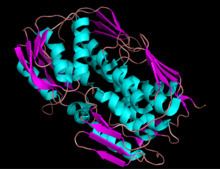EC number 2.5.1.19 ExPASy NiceZyme view | CAS number 9068-73-9 | |
 | ||
5-enolpyruvylshikimate-3-phosphate (EPSP) synthase is an enzyme produced by plants and microorganisms. It catalyzes the chemical reaction:
Contents
phosphoenolpyruvate + 3-phosphoshikimateThus, the two substrates of this enzyme are phosphoenolpyruvate (PEP) and 3-phospho-shikimate, whereas its two products are phosphate and 5-enolpyruvylshikimate-3-phosphate.
It is the biological target of the herbicide glyphosate, and a glyphosate-resistant version of this gene has been used in genetically modified crops.
Nomenclature
The enzyme belongs to the family of transferases, to be specific those transferring aryl or alkyl groups other than methyl groups. The systematic name of this enzyme class is phosphoenolpyruvate:3-phosphoshikimate 5-O-(1-carboxyvinyl)-transferase. Other names in common use include:
Structure
EPSP synthase is a monomeric enzyme with a molecular mass of about 46,000. It is composed of two domains, which are joined by protein strands. This strand acts as a hinge, and can bring the two protein domains closer together. When a substrate binds to the enzyme, ligand bonding causes the two parts of the enzyme to clamp down around the substrate in the active site.
EPSP synthase has been divided into two groups according to glyphosate sensitivity. Class I enzyme, contained in plants and in some bacteria, is inhibited at low micromolar glyphosate concentrations, whereas class II enzyme, found in other bacteria, is resistant to inhibition by glyphosate.
Shikimate pathway
EPSP synthase participates in the biosynthesis of the aromatic amino acids phenylalanine, tyrosine and tryptophan via the shikimate pathway in bacteria, fungi, and plants. EPSP synthase is produced only by plants and micro-organisms; the gene coding for it is not in the mammalian genome. Gut flora of some animals contain EPSPS.
Reaction
EPSP synthase catalyzes the reaction which converts shikimate-3-phosphate plus phosphoenolpyruvate to 5-enolpyruvylshikimate-3-phosphate (EPSP).
Herbicide target
EPSP synthase is the biological target for the herbicide glyphosate. Glyphosate is a competitive inhibitor of PEP, acting as a transition state analog that binds more tightly to the EPSPS-S3P complex than PEP and inhibits the shikimate pathway. This binding leads to inhibition of the enzyme's catalysis and shuts down the pathway. Eventually this results in organism death from lack of aromatic amino acids the organism requires to survive.
A version of the enzyme that both was resistant to glyphosate and that was still efficient enough to drive adequate plant growth was identified by Monsanto scientists after much trial and error in an Agrobacterium strain called CP4, which was found surviving in a waste-fed column at a glyphosate production facility; this version of enzyme, CP4 EPSPS, is the one that has been engineered into several genetically modified crops.
